Cloud-based AR leverages remote servers to process complex computations and deliver rich, dynamic content, enabling seamless updates and scalable experiences without taxing local device resources. On-device AR processes data directly on the user's hardware, offering low latency and offline functionality but limited by the device's computational power and storage capacity. Choosing between cloud-based and on-device AR depends on factors such as performance requirements, connectivity availability, and the need for real-time data processing.
Table of Comparison
| Feature | Cloud-Based AR | On-Device AR |
|---|---|---|
| Processing | Remote servers handle computation. | Local device handles computation. |
| Latency | Higher latency due to network dependency. | Low latency with instant responsiveness. |
| Internet Requirement | Requires stable internet connection. | No internet needed for core functions. |
| Storage | Uses cloud storage for assets and data. | Stores assets locally on the device. |
| Scalability | Highly scalable with server resources. | Limited by device hardware capacity. |
| Data Privacy | Potential data exposure during transmission. | Enhanced privacy with local data processing. |
| Updates & Maintenance | Centralized updates, easier deployment. | Requires device-specific updates. |
Introduction to Augmented Reality Technologies
Cloud-based AR leverages remote servers to process and store data, enabling complex rendering and real-time updates without taxing device resources. On-device AR relies on the device's hardware for processing, offering faster response times and offline functionality but limited by computing power. Choosing between cloud-based and on-device AR depends on factors like latency requirements, internet connectivity, and the complexity of the augmented content.
Defining Cloud-Based AR and On-Device AR
Cloud-Based AR processes augmented reality data and runs applications on remote servers, enabling real-time updates, large-scale data storage, and enhanced computational power. On-Device AR executes AR functions locally on smartphones, tablets, or AR glasses, offering faster response times and offline capabilities without relying on constant internet connectivity. Both approaches impact user experience, with Cloud-Based AR supporting complex, data-intensive applications, while On-Device AR ensures low latency and privacy by minimizing data transmission.
Architecture and Infrastructure Comparison
Cloud-based AR relies on remote servers and high-speed internet to process complex computations and deliver real-time data, enabling scalable and resource-intensive applications. On-device AR performs processing locally using the device's CPU, GPU, and dedicated AI chips, which reduces latency and increases privacy but limits the complexity of AR experiences. The architecture of cloud-based AR requires robust network infrastructure and cloud services integration, while on-device AR depends on advanced hardware capabilities and optimized software for offline functionality.
Performance and Latency Considerations
Cloud-based AR leverages remote servers to process data, enabling complex computations and real-time updates but often faces higher latency due to network dependencies. On-device AR executes processing locally on hardware like smartphones or AR glasses, resulting in lower latency and more immediate responsiveness, critical for immersive user experiences. Performance in cloud-based AR can fluctuate with bandwidth and server load, whereas on-device AR performance is limited by the device's computational power and battery life.
Scalability and Resource Requirements
Cloud-Based AR leverages powerful remote servers to handle complex computations, enabling scalable deployment across multiple devices without taxing local hardware resources. On-Device AR processes data directly on the user's device, resulting in lower latency but limited scalability due to hardware constraints and higher resource consumption. Scalability is significantly enhanced in Cloud-Based AR as it offloads processing demands, while On-Device AR requires advanced device capabilities to maintain performance across varied applications.
Data Security and Privacy Implications
Cloud-Based AR relies on remote servers to process and store user data, raising concerns about data security breaches and unauthorized access due to centralized data repositories. On-Device AR processes and stores sensitive information locally, minimizing exposure to external threats and enhancing user privacy by limiting data transmission over networks. Organizations must evaluate compliance with data protection regulations such as GDPR and CCPA when choosing between these AR deployment models to mitigate privacy risks.
Content Delivery and Streaming Capabilities
Cloud-based AR leverages remote servers to deliver rich, high-resolution 3D content with minimal device processing, enabling dynamic updates and seamless streaming of immersive experiences. On-device AR relies on local processing power, ensuring low-latency interactions but is limited by device storage and computing capabilities for content complexity. Content delivery in cloud-based AR benefits from adaptive streaming protocols, optimizing bandwidth use and scalability for multi-user environments, while on-device AR prioritizes real-time responsiveness and offline functionality.
Use Case Suitability and Industry Applications
Cloud-based AR excels in complex, data-intensive scenarios such as remote collaboration and large-scale industrial maintenance, leveraging real-time data processing and extensive content libraries. On-device AR offers low-latency, privacy-focused experiences ideal for retail, gaming, and training applications where immediate responsiveness and offline functionality are critical. Industries like healthcare and manufacturing benefit from cloud AR's continuous updates and scalability, while consumer electronics and education often rely on on-device AR for seamless, high-performance user interactions.
Offline Functionality vs. Always-Connected Experiences
Cloud-based AR relies on real-time data processing and streaming, enabling complex, always-connected experiences that leverage vast cloud resources for high-quality visuals and interactive content. On-device AR processes data locally, ensuring reliable offline functionality and low latency, ideal for scenarios with limited or intermittent internet connectivity. Choosing between cloud-based and on-device AR depends on prioritizing seamless online interactivity versus consistent offline performance.
Future Trends in AR Deployment Models
Cloud-based AR leverages powerful remote servers to deliver complex computing tasks and real-time data updates, enabling seamless scalability and enhanced user experiences across various devices. On-device AR processes information locally, offering faster response times and offline capabilities, which are critical for latency-sensitive applications and privacy-centric use cases. Future trends indicate a hybrid AR deployment model integrating cloud and edge computing to balance performance, bandwidth efficiency, and user privacy in immersive augmented reality environments.
Cloud-Based AR vs On-Device AR Infographic

 techiny.com
techiny.com